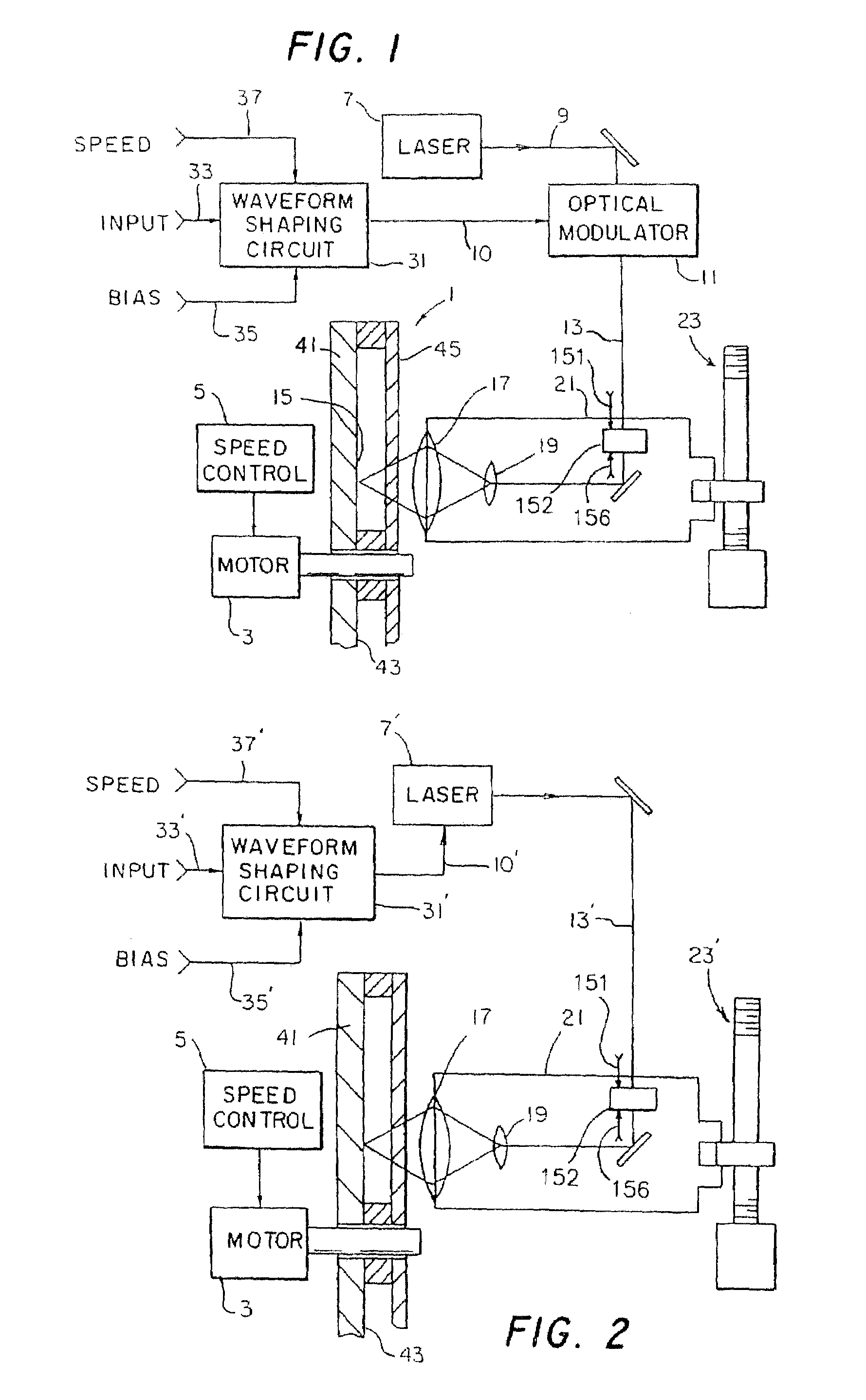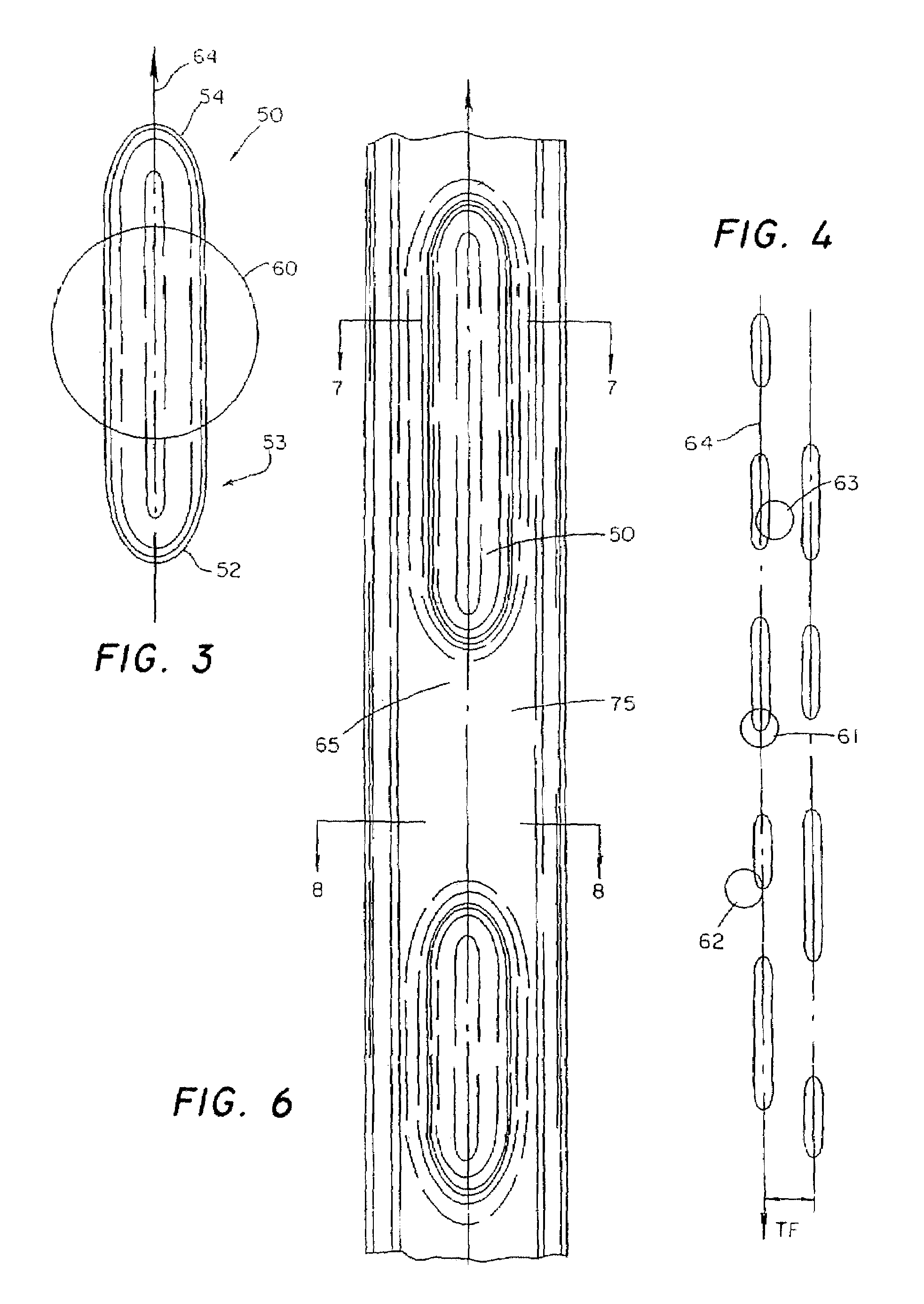Because the PR method is a photoengraving process, and the
photoresist will not be of absolutely uniform consistency, the sidewalls will be somewhat rough.
Failure to fully
expose the
photoresist (resulting in residual
photoresist at the bottom of the pit) by utilizing reduced write beam intensity will create pits or grooves having an essentially triangular section.
Such shallow features, created by the PR method, have been found generally to produce “noisy” data output readings from replicated discs, because of inherent roughness in the etched photoresist layer and greater susceptibility to write
laser noise.
These compromise detection accuracy, because the playback
signal amplitude is affected by surface characteristics.
Once again, regardless of the particular application, the PR method is essentially an
etching process, and even if the photoresist is fully exposed, a certain amount of roughness inevitably occurs on the pit sidewall surfaces.
While this has not proved to be a particularly significant problem in ordinary CD-ROM mastering applications, the PR method of disc mastering is unconducive to production of hybrid CD masters from which hybrid CDs can be rapidly manufactured with a low
rejection rate.
This is due to at least four inherent characteristics of the PR method: (1) it tends to generate features with sharp corners, in transverse section, causing molding problems that increase
cycle time; (2) shallow features, created by partial
exposure of the photoresist, are noisy when read; (3) it is a generally difficult process to control; (4) the inherent roughness of PR-generated data pits and grooves impedes accurate hybrid CD
data retrieval.
Furthermore, this problem of roughness in PR-generated disc masters can only become more troublesome as data densities increase beyond the present CD and DVD level of approximately 4.2 gigabytes per data layer, and
data retrieval strategies necessarily become more sophisticated.
On the other hand, cooling occurs almost instantly when the beam is shut off, resulting in relatively blunter trailing edges.
Unfortunately, this is complicated by the fact that the criteria inherent in accurate HF detection and in accurate “PP” (push-pull) tracking, required by the Red Book specifications in all pre-recorded CD applications, are mutually exclusive.
However, because this is accomplished by reducing the write beam intensity to near the
thermal threshold, the resulting land groove must necessarily be quite narrow.
But this actually compromises PP detection, because another feature of the PP / HF dichotomy is that optimal PP detection is realized with a groove that is wider than one that would optimize HF detection.
Furthermore, HF detection is not significantly addressed by Schoofs.
But that would actually compromise PP detection by deepening the groove and would also compromise HF detection by causing pit / land transitions to be more difficult to detect, thus negatively counterbalancing any proposed PP improvements.
In the context of hybrid disc manufacture, very similar problems will also occur in following the Nakagawa, Yanagimachi and Ha teachings, to be discussed shortly.
Failure to properly optimize the overall disc
production line, by ongoing testing of final (processed) hybrid discs and corresponding adjustment of the mastering parameters, in a
feedback loop process (see, below), may yield stampers that are reasonably good mirror images of the masters and clear replica hybrid discs whose features are closely similar to those of the master, and yet result in final hybrid discs whose ROM data marks and pre-grooves do not exactly display the cross-sectional shape of those in the master.
Despite confident assertions made in the prior art, their teachings do not, individually or collectively, appear capable of providing a method, apparatus or structure that offers the range of selectively adjustable parameters, nor the general flexibility, necessary to maximize
Figure of Merit and thus promote reliable production of hybrid discs that satisfy Red Book and Orange Book specifications in a high-speed manufacturing environment.
However, it is not seen how Nakagawa proposes to generate the rectangular section pre-grooves.
In fact, this would be very difficult, if not literally impossible, to accomplish by the means taught.
It will perhaps be appreciated that this double
exposure of the photoresist would, at best, be a very difficult process to control.
Furthermore, even if Nakagawa, or one of ordinary skill practicing his teachings, could somehow create disc masters with ROM pits and R band pre-grooves of rectangular cross-section—which is highly unlikely—it would be nearly impossible to replicate such masters, simply because the molded clear replica hybrid discs would adhere strongly to the stampers, which would display millions of features having vertical sides, rather than the slanted sides of the trapezoidal cross-section features normally seen in PR-generated masters.
As mentioned above, the manner in which Nakagawa creates the pre-grooves (reduced
exposure of the photoresist in those areas) would make it highly unlikely that this method could achieve the desired rectangular cross-section pre-grooves, or that such masters, even if generated, could produce replicas meeting Orange Book specifications.
In other words, Nakagawa's simple expedient of allowing the cross-sectional shape of the respective features to cause the desired difference in thermally-active
recording layer thickness would probably not succeed.
Ultimately, if Nakagawa's teachings were followed, using modem high speed dyes, not only would tracking be severely compromised, particularly in the hybrid disc R band(s), but also HF detection of the R band pits would likewise be more difficult, as these pits would essentially be squeezed into the narrow pre-grooves and “bulge” radially outwardly from them.
Hybrid discs that fail to meet the specs are useless.
This is in addition to the problem, as in Nakagawa, that the R band pits and grooves will not readily lend themselves to HF or PP detection.
Furthermore, Yanagimachi does not teach how to independently control the width and depth of the ROM grooves, the ROM pits and the R band grooves.
This may, or may not, be because all publications known to the applicants rely on the photoresist method of mastering the hybrid discs, which, as has been shown above, is extremely difficult, if not impossible, to utilize in producing masters that can be replicated to manufacture hybrid discs meeting the required specifications.
Whatever the reasons, it appears that in-spec hybrid discs cannot be commercially manufactured in accordance with the prior art.
 Login to View More
Login to View More 


